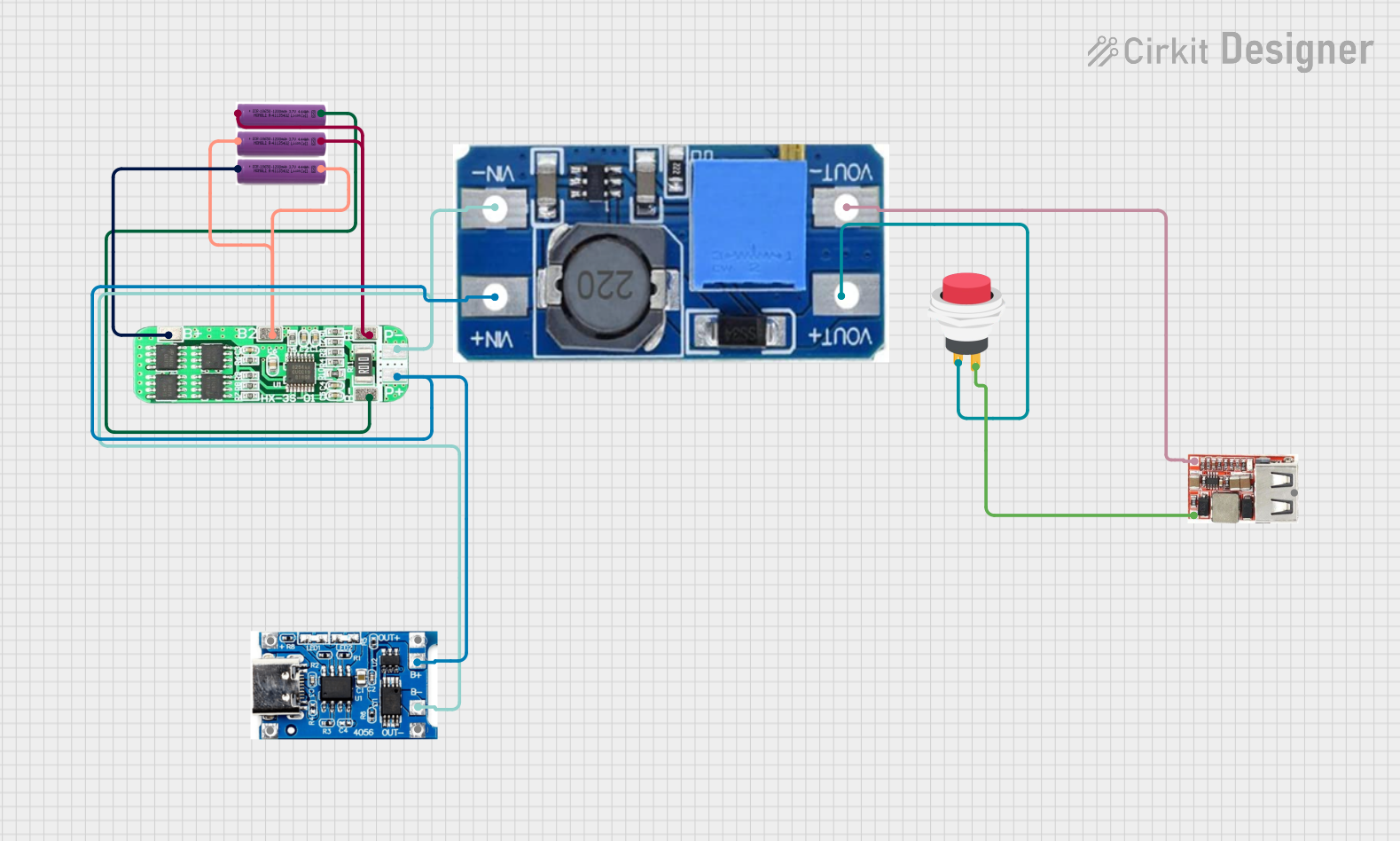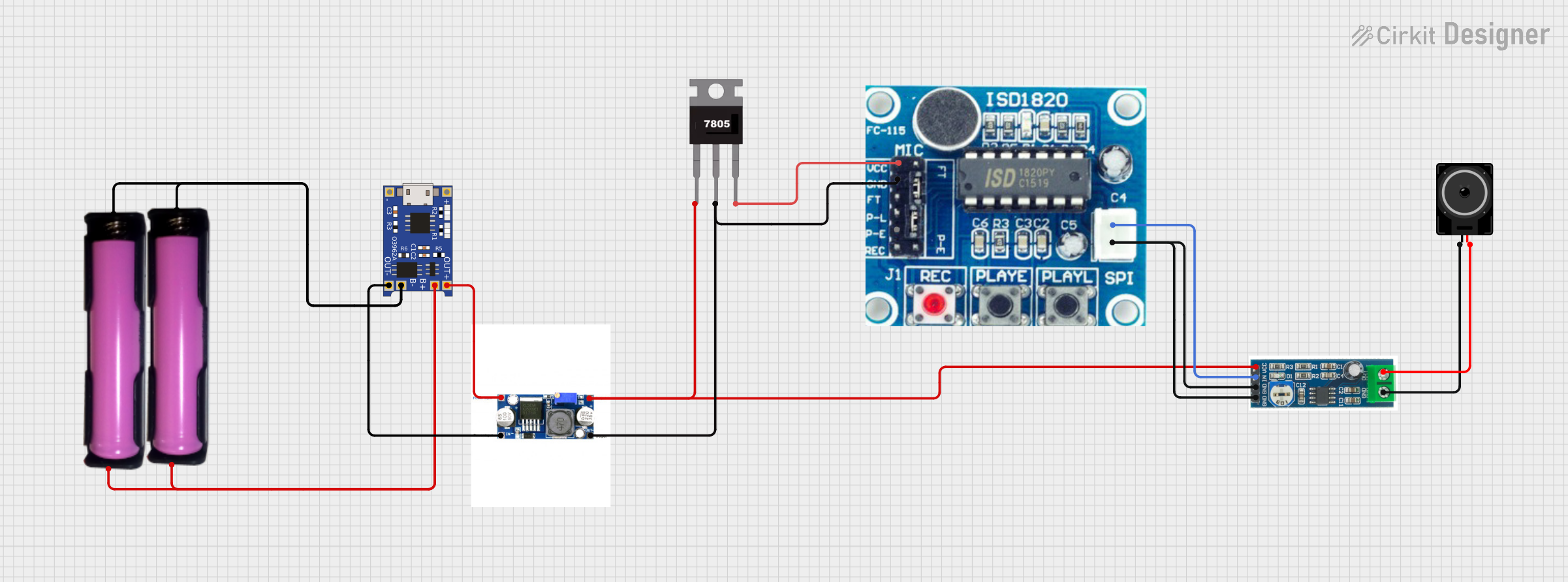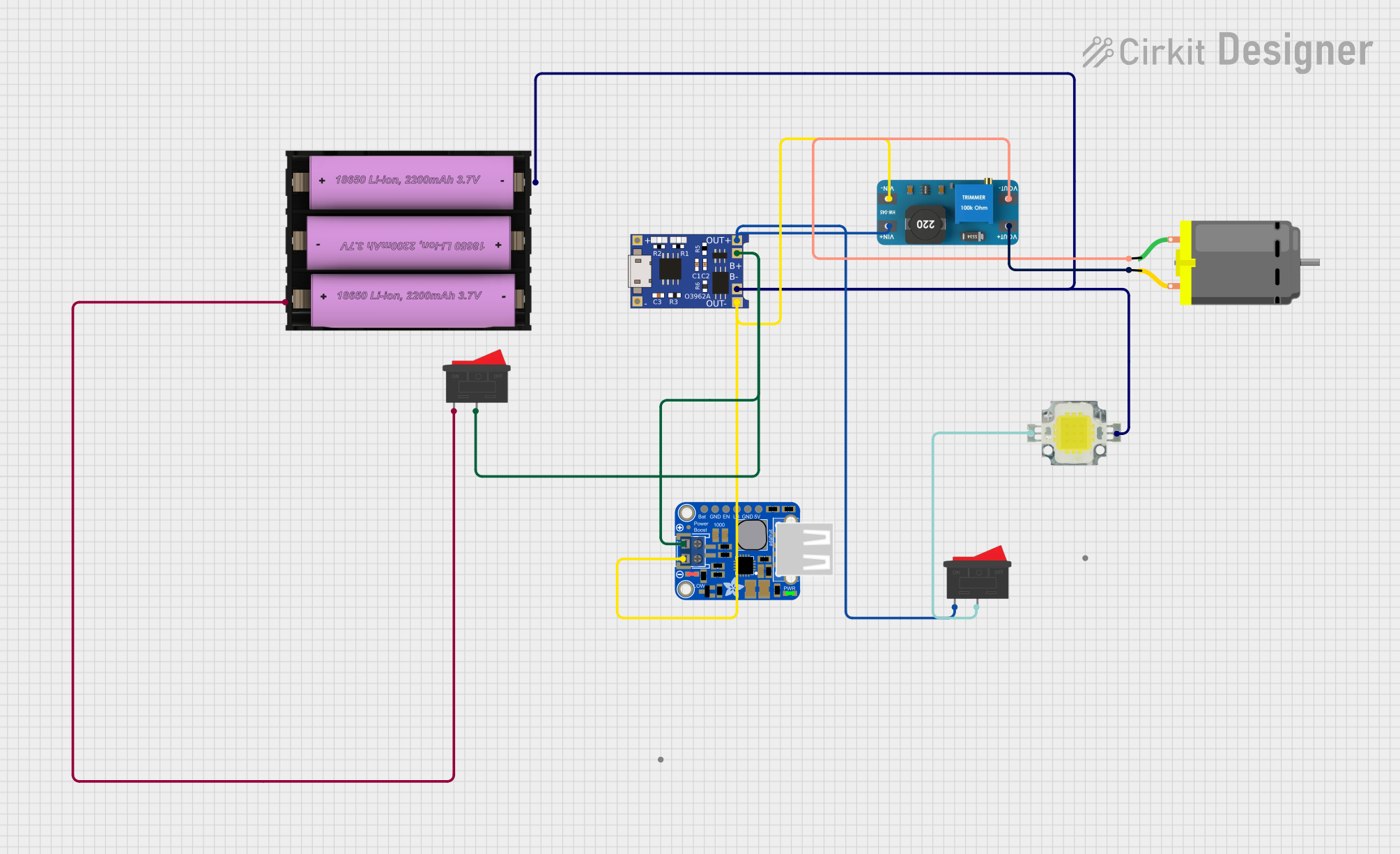
How to Use lipo battery charger module: Examples, Pinouts, and Specs
 Design with lipo battery charger module in Cirkit Designer
Design with lipo battery charger module in Cirkit DesignerIntroduction
The LiPo Battery Charger Module is an essential device for safely charging Lithium Polymer (LiPo) batteries. These rechargeable batteries are widely used in portable electronics, drones, RC vehicles, and various DIY projects due to their high energy density and lightweight characteristics. The module ensures that LiPo batteries are charged within their safe voltage and current limits, preventing overcharging, which can lead to battery damage or potential hazards.
Explore Projects Built with lipo battery charger module

 Open Project in Cirkit Designer
Open Project in Cirkit Designer
 Open Project in Cirkit Designer
Open Project in Cirkit Designer
 Open Project in Cirkit Designer
Open Project in Cirkit Designer
 Open Project in Cirkit Designer
Open Project in Cirkit DesignerExplore Projects Built with lipo battery charger module

 Open Project in Cirkit Designer
Open Project in Cirkit Designer
 Open Project in Cirkit Designer
Open Project in Cirkit Designer
 Open Project in Cirkit Designer
Open Project in Cirkit Designer
 Open Project in Cirkit Designer
Open Project in Cirkit DesignerTechnical Specifications
Key Technical Details
- Input Voltage: Typically 4.5V to 6V
- Charge Current: Adjustable (commonly up to 1A or 2A)
- Battery Voltage: 3.7V nominal (single cell)
- Charge Cutoff Voltage: 4.2V ± 1%
- Operating Temperature: -10°C to +85°C
Pin Configuration and Descriptions
| Pin Name | Description |
|---|---|
| BAT+ | Positive terminal of the battery |
| BAT- | Negative terminal of the battery |
| IN+ | Positive input voltage |
| IN- | Negative input voltage (GND) |
| STAT | Status pin indicating charging state |
Usage Instructions
How to Use the Component in a Circuit
Connect the Power Supply:
- Connect a power supply to the IN+ and IN- pins, ensuring it matches the module's input voltage requirements.
Attach the LiPo Battery:
- Connect the LiPo battery's positive terminal to the BAT+ pin and the negative terminal to the BAT- pin.
Monitoring the Charging Process:
- The STAT pin can be used to monitor the charging status. When charging, the STAT pin is typically LOW, and when the charge is complete, it goes HIGH or is left floating, depending on the module design.
Adjusting Charge Current (if applicable):
- Some modules come with an on-board potentiometer or a set of resistors to adjust the charging current. Follow the manufacturer's instructions to adjust the current to match your battery's specifications.
Important Considerations and Best Practices
- Voltage and Current Ratings: Always ensure that the power supply and the charging current are within the specifications for both the module and the LiPo battery.
- Heat Dissipation: Charging can generate heat. Ensure the module is in a well-ventilated area and consider adding a heatsink if necessary.
- Battery Quality: Use high-quality LiPo batteries with protection circuits to prevent issues like over-discharge and short circuits.
- Module Placement: Keep the module away from metal surfaces and other components that can cause short circuits or interfere with the charging process.
Troubleshooting and FAQs
Common Issues
- Battery Not Charging: Ensure all connections are secure and the power supply is within the required voltage range. Check the battery's health and the module's status pin for indications of charging activity.
- Module Overheating: Reduce the charging current if adjustable, improve ventilation, or add a heatsink to the module.
- Inaccurate Charge Termination: Confirm that the battery voltage and the module's charge cutoff voltage are compatible. Some modules may require calibration.
FAQs
Q: Can I charge multiple LiPo batteries at once with this module? A: No, this module is designed for single-cell LiPo batteries. For multiple cells, you need a module with balancing functions or a dedicated multi-cell charger.
Q: Is it safe to leave the battery connected to the charger after it's fully charged? A: The module is designed to stop charging once the battery is full. However, it's good practice to disconnect the battery once the charge cycle is complete.
Q: What should I do if the STAT pin doesn't change state after a long time? A: Check the battery and power supply connections. If the issue persists, the battery may be faulty or the module may be damaged.
Example Arduino UNO Connection and Code
// Example code to monitor LiPo Battery Charger Module status with Arduino UNO
const int statusPin = 2; // Connect STAT pin of the module to digital pin 2 on Arduino
void setup() {
pinMode(statusPin, INPUT);
Serial.begin(9600);
}
void loop() {
int chargingStatus = digitalRead(statusPin);
// When STAT pin is LOW, battery is charging
if (chargingStatus == LOW) {
Serial.println("Battery is charging...");
} else {
// When STAT pin is HIGH or floating, charging is complete
Serial.println("Charging complete or no battery present.");
}
delay(1000); // Check status every second
}
Remember to adjust the statusPin variable to match the actual connection on your Arduino UNO. This code will provide a simple serial output indicating the charging status of the LiPo battery.